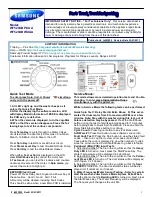
5
6
ʋ
ʋ
ʋ
ʋ
ʋ
ʋ
ʋ
ʋ
ʋ
ʋ
ʋ
ʋ
ʋ
ʋ
ʋ
ˎ
&
'
ˎ
Ù
ˎ
Ú]
a
ʋ
ʋ
3
2
1
Ý]
7
A
8
Þ
a
a
Ü
a
>
Ú
a
Important Information
Your dryer is designed to be particularly energy efficient. Its technical features include a
refrigeration circuit, which uses energy efficiently in a similar way to a refrigerator.
The dryer's heat exchanger is cleaned automatically during drying.
The fluff filters and filter in the condensation container must be cleaned regularly.
Never operate the dryer without the fluff filters and/or condensation container with filter.
ʑ
Fluff filters
During drying, fluff and hair from the laundry is trapped by the fluff filter. Blocked fluff filters
may impair the heat exchange process.
The fluff filters must therefore be cleaned after every drying cycle. Rinse regularly under
running water
a
page 4
.
ʑ
Filter in the condensation container
The filter in the condensation container cleans the condensation. This condensation is
required for the automatic cleaning process. The filter should be cleaned regularly under
running water. Empty the condensation container before cleaning the filter
a
page 4/9
.
ʑ
Fabrics
Do not dry any fabrics that have come into contact with solvents, oil, wax, grease or paint:
e.g. hair styling products, nail varnish remover, stain remover, cleaning solvent. etc.
Empty all pockets.
Do not dry non-breathable fabrics.
Avoid drying items that produce a lot of fluff.
Woollens should be refreshed only, using the woollens programme.
Information on laundry ...
Labelling of fabrics
Follow the manufacturer's care information.
(
Dry at normal temperature.
'c
Dry at low temperature
a
in addition, select
Ù
(Low heat)
.
)c
Do not machine dry.
Always observe the safety instructions on page 13.
Do not tumble-dry the following fabrics, for example:
– Non-breathable fabrics (e.g. rubber-coated).
– Delicate materials (silk, curtains made from synthetic material)
a
these may crease.
– Oil-stained laundry.
Drying tips
– To ensure an even result, sort the laundry by fabric type and drying programme.
– Always dry very small fabrics (e.g. baby socks) together with
large items of laundry (e.g. towels).
– Close zips, hooks and eyelets, and button up covers.
Tie fabric belts, apron strings, etc. together
– Do not over-dry easy-care laundry
a
Risk of creasing.
Allow laundry to finish drying in the air.
– Do not dry woollens in the dryer. They may, however, be refreshed
a
page 7
6 min
;
(Wool finish)
programme.
– Do not iron laundry immediately after drying; fold items up and leave for a while
a
residual
moisture will then be distributed evenly.
– The drying result depends on the type of water used during washing.
a
Fine adjustment
of the drying result page 6.
– Knitted fabrics (e.g. T-shirts, jerseys) often shrink slightly the first time they are tumble-dried.
a
Do not use the
{
(Cupboard dry extra)
programme.
– The drying of starched laundry should be limited.
a
Starch leaves behind a coating that
impairs drying.
– When washing laundry that is to be tumble-dried afterwards, use the correct amount of
fabric softener as specified in the manufacturer's instructions.
– For pre-dried, multi-layered fabrics or small, individual items of laundry, use the Timed
programme. Also suitable for subsequent drying.
Environmental protection/energy-saving tips
– Before drying, spin the laundry thoroughly in the washing machine
a
the higher the spin
speed, the shorter the drying time will be, thus less energy is consumed. Also spin easy-
care laundry.
– Use the maximum recommended capacity, but do not exceed it
a
Programme overview
page 7
.
– Make sure the room is well ventilated during drying
.
– Do not cover or seal the air inlet.
ò
4
Þ]]Ý
Ü
a
Û
a
Fine adjustment of the drying result
Adjustment of the levels of dryness
1 x to
the right
Press and hold
Ù
(Low heat)
and turn 5 x to the right
Press
Ù
(Low heat)
until the
required level is reached
Turn to
>
(Off)
Turn to
>
(Off)
L:00, L:01, L:02, L:03 are shown in sequence.
Short signal when changing from level 3 to 0, otherwise long
signal.
c
@
c
c
A
8
Þ
4
c
ø
@
c
Þ
@
{
@
;
Ø
ò
A
8
a
{
Þ
4




























